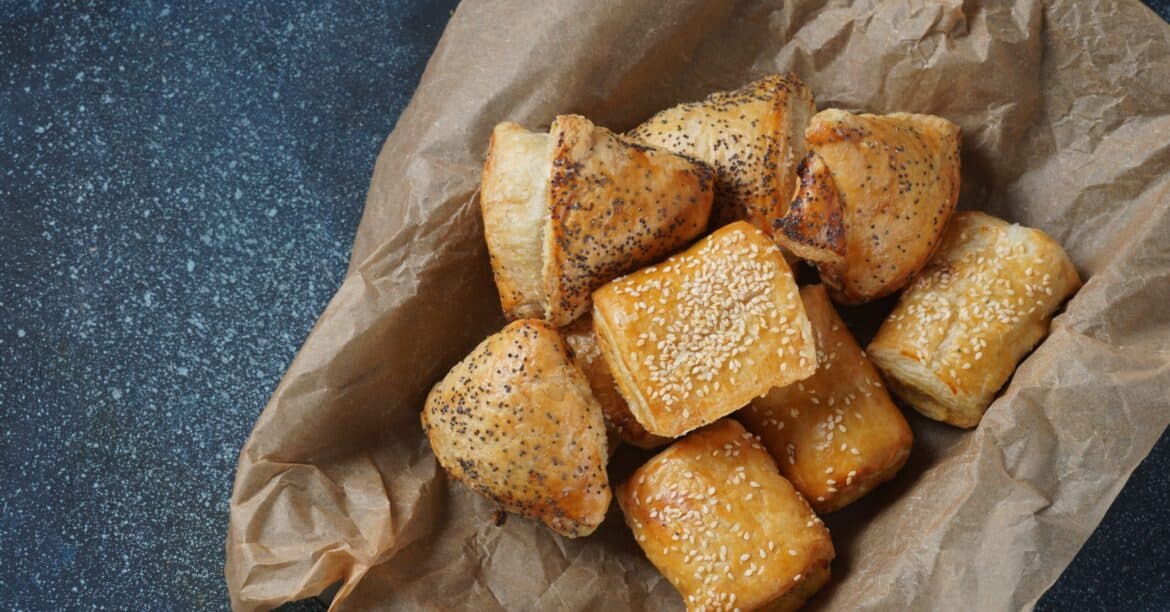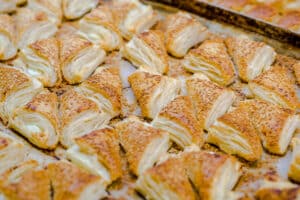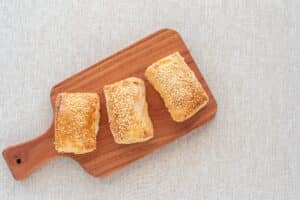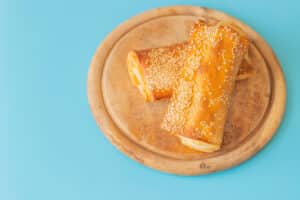Unfamiliar with the hard-and-fast rules of boureka culture? Before you rush to buy these flaky savory pastries in the wake of Passover, let us help.
Originally brought to Israel by Sephardic Jews during the pre-state years of Israel, bourekas have made their mark on Israeli cuisine, standing out as an easy-to-find and even easier-to-eat pastry that can be found in any corner bakery throughout the country.
After being expelled from Spain over the course of several centuries, many Sephardic Jews sought refuge in the Ottoman Empire, where they adapted the local “börek” to their dietary laws, combining it with empanadas to create what we now recognize as bourekas.
Today, Israeli bourekas come in a variety of shapes and can be stuffed with even more types of fillings, be they cow or goat cheese, mushrooms, spinach, potatoes or even pizza toppings.
While newcomers to the boureka scene may find themselves overwhelmed by the dazzling array of bourekas on display, there are a few key indicators to understanding all of that mouth-watering madness.
Firstly, there’s good old-fashioned tradition: Certain shapes have meant certain fillings for decades and even centuries, and these traditions are so deeply hard-wired into the DNA of modern bourekas that it’d be tough to find an outlier.
Further reinforcing that system, however, is organized religion.
In 2013, the Chief Rabbinate of Israel decreed that in order to be a kosher-certified seller of bourekas, bakeries need to fill specific shapes with specific fillings. They did this to give kosher-conscious consumers a way to discern between dairy and non-dairy bourekas without having to bite into them (which is harmless enough, but you have to make sure to pay for them first).
These two factors combine into hard-and-fast rules that can make shopping for this savory snack in Israeli bakeries a breeze.
Let’s delve into the world of Israeli bourekas and explore the traditional fillings associated with different shapes.
Disclaimer: The subject matter of this article may be considered highly controversial (it has even fostered stark disagreements among the ISRAEL21c staff). While it does present a solid foundation of boureka familiarity, the safest way to become an expert is to get out there and explore for yourself!
Triangle bourekas
A true mainstay of the genre and the most common you will find in bakeries and supermarkets the length and breadth of Israel, as well as at all preschool and school parties, these three-pointed puff pastries are usually filled with savory cheeses, such as Bulgarian or feta.
Square bourekas
The backbone of the non-dairy bourekas family is also the most recognizable of shapes (this bold statement will no doubt generate major backlash from the circle-loving community, but ISRAEL21c journalists are nothing if not bravely willing to stand in the face of adversity in the name of the truth).
By and large, these run on a spectrum of square to rectangle, and are nearly always filled with everyone’s favorite ground-apple, the potato.
Half-moon bourekas
The elegant half-moon boureka is often filled with smooth Bulgarian cheese, a common boureka filling. The half-moon manages to stand out from the pack, however, thanks to the short-crust pastry encasing the salty cheese center.
Stick bourekas
Ranging from modest to comical in length, stick-shaped bourekas are filled with savory cheeses, much like their triangular compatriots.
The primary differences between the two is that these are typically made with phyllo pastry, whereas triangles are constructed with puff pastry — and also that sticks are perfect for the boureka-lover on the go.
Because of the phyllo, these are potentially a healthier option than regular bourekas, as they have no trans fats, saturated fat or cholesterol.
Spiral bourekas
Usually, you’re going to find that spiral bourekas are pizza flavored. This is denoted by a reddish, tomato-shaded filling and/or the presence of olives.
HOWEVER, just because it’s “pizza flavored” doesn’t necessitate the presence of cheese. Sometimes it does, sometimes it doesn’t — your mileage may vary.
In some cases, you may find that the spiral is not filled with pizza sauce and toppings, and in fact embodies a sort of “dealer’s choice” scenario, wherein the bakery has the ultimate say in what gets inserted into this Fibonacci-inspired work of pastry art.
Rhombus bourekas
You will not encounter a more catch-all variety of boureka than the lowly rhombus. These cowardly confections may have four corners and four sides, but their slanted nature betrays their inherent unreliability.
The rhombus boureka has the potential to soar as high as the greatest (such as when it’s filled with a salty and earthy spinach and onion mixture) but it can also sink to unknown culinary depths (carrots and sweet potatoes may have their place at the table, but not in the form of bourekas). Don’t even get me started on poppy seeds.
Ring bourekas
Speaking candidly: I’ve never seen these before in my entire life. They could have anything inside of them. Good luck.
Originally posted at israel21c.org





